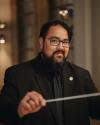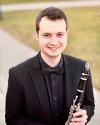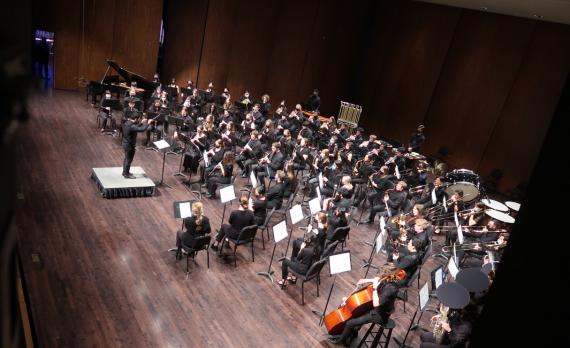The Campus Band (Solomon Encina, conductor) and Concert Band (David Stewart, Yuman Wu, conductors) present "Passages," a program of music by Clifton Williams, Frank Ticheli, Masanori Taruya, Rossano Galante, Samuel Hazo, Fred J. Allen, and others. This concert also includes the debut of a new community ensemble, the University Band.
Program
Concert Band
David Stewart, Yuman Wu, conductors
Chant and Jubilo: W. Francis McBeth
Loch Lomond: Frank Ticheli
Last Letter From Murdoch: Masanori Taruya
Campus Band
Solomon Encina, conductor
Fortress: Frank Ticheli (b. 1958)
A Childhood Remembed (2013): Rossano Galante (b. 1967)
Symphonic Suite (1957): Clifton Williams (1923 - 1976)
I. Intrada
II. Chorale
III. March
IV. Antique Dance
V. Jubiliee
UW University Band
Solomon Encina, David Stewart, directors
Rush (2006) – Samuel Hazo (b. 1966)
When the Stars Began to Fall (1992) – Fred J. Allen (b. 1953)
An Original Suite (1928) – Gordon Jacob (1895 - 1984)
I. March
II. Intermezzo
III. Finale
Program Notes
Chant and Jubilo was commissioned by Jerry Loveall for the Four States Bandmasters Convention in Texarkana, Texas, and was first performed by the Four States Bandmasters Band in January of 1962 with the composer conducting. It is a work in two connected contrasting movements. The melodic material in the Chant is derived from a ninth century Greek hymn of rogation. It is a modal movement reminiscent of the early church organum and should be done in a very sensitive manner, with the Jubilo contrasting with its explosive lower brass and percussion. The composer also used this source material in his Hymn for Band, a junior high piece written two years earlier.
- Program Note by Jesse Leyva
Ticheli’s setting of the famous folksong is simple yet charming, preserving faithfully the melody and adding interesting harmonic vocabulary. Loch Lomond tells the tale of two Scottish soldiers who were imprisoned at Carlisle Castle in England, following the Battle of Culloden Moor. One of the soldiers was to be executed, while the other was to be set free. According to Celtic legend, those who died in foreign lands had their spirits travel to their homelands through the “low road,” the route for the souls of the departed. The song is from the point of view of the soldier to be executed, who tells his friend “ye’ll tak’ the high road and I’ll tak’ the low road,” in effect saying that the freed soldier will return alive, while he himself would return in spirit. He remembers his past and the “bonnie lass” (pretty girl) he will never see again, and sadly accepts death.
Loch Lomond was commissioned by the Stewarton Academy Senior Wind Ensemble of East Ayrshire, Scotland, Nigel Durno, conductor. It received its premiere on 18 June 2002 by the commissioning ensemble at Royal Concert Hall in Glasgow, Scotland.
- Program Notes by Nikk Pilato
Last Letter from Murdoch: The Titanic, which departed for New York as the world's largest luxury cruise ship in April 1912, sank to the bottom of the ocean without finishing its maiden voyage. Murdoch was the first officer on board the Titanic and one of the crew who bravely rescued passengers until the last moment the ship sank.
During his voyage, it was his daily routine to write letters to his family, which spelled out his concerns for his family as well as his current situation. The "last letter" from Murdoch may have talked about the boats crowded with passengers, the beautiful view of the Atlantic Ocean, and the accident that foreshadowed the sinking.
The piece depicts the scenery and the thoughts that Murdoch would have written in the letter, with a Celtic melody. I hope you listen and play as if you were reading the last letter from Murdoch.
- Program Note by composer
Fortress was composed as a tribute to the composer's former band director, Robert Floyd of Richardson, Texas. Although Ticheli was already an international award winner, this was his first published work for concert band.
The first 19 bars of Fortress are taken from the composer's piano score for a 1987 theater production of Moliere's Don Juan. Of the dozens of short snips, each of which portrays a different character, this passage represents the dual personality of Don Alonso -- on the one hand chivalrous and honor bound; on the other hand sinister and ruthless.
- Program Note by composer
A Childhood Remembed: Close your eyes and imagine a time of carefree days and magical star-filled nights. Sprightly melodic lines play tag with more lyrical, lush sonorities, taking audiences back to their own childhoods. This light composition captures youth and innocence through the eyes of a child.
- Program Note from publisher
Symphonic Suite: The suite consists of five movements related through the use of the principal theme. In each movement a new theme is also introduced, and in the last movement several themes are developed simultaneously. The suite begins with an Intrada which suggests a solemn processional in fanfare style. The following movement, Chorale, is based on a melody in the first cornet which has more than a hint of blue in it. March is marked allegro vivo and is based on a short fanfare-like motif heard at the beginning. After many repetitions it works up to a fine climax for full band at the end. The Antique Dance features a modal melody in the flute with percussion accompaniment. Jubilee is the climactic movement of the suite. Marked allegro con brio, it is written in sonorous triadic harmony throughout. With a few contrasting sections, the movement is based primarily on a chordal-rhythmic motif.
- Notes from “Program Notes for Band” and Gene A. Braught
This commission was the idea of Jodi Tuthill at Wenger Corporation. Two years ago, she approached me with the idea of Wenger celebrating their 60th anniversary by commissioning a piece for wind band. Their anniversary would be noted by the commission, and band directors would have an extra piece in their repertoire courtesy of Wenger. During its composition, Rush actually turned into a piece I never thought I would write: Ride Pt. II. I used percussive patterns that I heard from the machinery at the Wenger Plant during my visit to Owatonna, Minn. Once those rhythmic patterns were established, I added some themes that were upbeat and celebratory. After the piece was about half done, I thought to myself that it picks up right where my piece Ride left off. When it was totally completed, there was no doubt in my mind. People were going to call it a "follow-up" tune whether I labeled it as such or not. The composition was all done and I still hadn't thought of a title for what was basically Ride 2. I mentioned this to David Starnes at Kennesaw Mountain High School. Later that same day I thought of the name Rush and liked the way it fit. The next morning, David called me and said, "Sam, I have the perfect name for Ride part II. Tell me if you like it... Rush."
- Program Note by composer
My Lord, What a Mornin' is one of many anonymous spirituals sung in the fields and in worship by African-American slaves in the 19th century. In this setting, sonorities of the band are utilized that express a longing for the end of time, when there will be no sorrow, no pain. The last line of the refrain serves as the title for this setting.
- Program Note from score
An Original Suite (1928) was originally entitled Suite for Military Band, and was composed while Jacob was a student at the Royal Academy of Music. The publishing company Boosey & Hawkes gave the suite its title. Jacob did not like the title and unsuccessfully tried to have it changed. The reason for the designation of An Original Suite is explained by Jacob:
At the time very little original music was being written for what was the “military” band, so the title was a way of distinguishing that it was an original work rather than an arrangement -- not that the music was very original in itself ... The slow movement is Irish rather than English “folky.” The reason being that Londonderry Air was extremely popular and much admired by the 1920s.
- Program Note from University of North Texas Concert Band concert program, 23 November 2015
|
UNIVERSITY OF WASHINGTON CONCERT BAND FLUTE OBOE CLARINET BASS CLARINET ALTO SAXOPHONE TENOR SAXOPHONE BARITONE SAXOPHONE BASSOON HORN TRUMPET TROMBONE EUPHONIUM TUBA PERCUSSION PIANO STRING BASS UNIVERSITY OF WASHINGTON CAMPUS BAND PICCOLO FLUTE OBOE BASSOON CLARINET BASS CLARINET ALTO SAXOPHONE TENOR SAXOPHONE HORN TRUMPET TROMBONE EUPHONIUM TUBA PERCUSSION UNIVERSITY OF WASHINGTON UNIVERSITY BAND PICCOLO FLUTE OBOE BASSOON CLARINET BASS CLARINET ALTO SAXOPHONE TENOR SAXOPHONE BARITONE SAXOPHONE TRUMPET TROMBONE EUPHONIUM TUBA PERCUSSION |
Biographies

Solomon Encina is a Graduate Assistant at the University of Washington, where he is pursuing a Doctor of Musical Arts (D.M.A.) in Instrumental Conducting. Solomon holds a Bachelors of Music degree in Instrumental Performance in Percussion from California Baptist University. He also holds a Masters in Music Education degree from Azusa Pacific University where he studied under Dr. Alexander Koops and Dr. John Burdett.
Solomon is a native of the Southern California region, where he has taught and arranged music for several high quality institutions. Most recently, he served as the Director of Bands at Los Osos High School in Rancho Cucamonga, CA, where the band, orchestra and color guard program regularly received high distinction awards at festivals throughout the state under his direction. During this time he also performed as a percussionist with several touring groups throughout the United States and as a guest conductor of the European Tour for Southern California Ambassadors of Music. After several years as a high school educator, Solomon is thrilled to begin pursuing his highest academic aspirations by attending UW to study under Professor Timothy Salzman.
Solomon Encina has affiliations with the National Association for Music Education (NAfME), the College Band Directors National Association (CBDNA), the California Music Educators Association (CMEA), and the Southern California School Band and Orchestra Association (SCSBOA). Solomon Encina is proudly endorsed by the Vic Firth Company and is a part of the Vic Firth Education team.

David Stewart is a Graduate Assistant at the University of Washington, where he is pursuing a Doctor of Musical Arts (D.M.A.) in conducting. David holds degrees in music performance and music education from Central Washington University and received a Master of Music from the University of Montana. A native of the Pacific Northwest, he attended Mercer Island High School and spent his weekends playing in the Seattle Youth Symphony Orchestra. His early experiences working with influential music educators shaped his ambition to become a band director himself. After realizing this dream and teaching at Graham-Kapowsin High School for four years, he decided to further his education and focus on conducting. As a performer, David has achieved notable success. He won his university's concerto competition as a freshman and received the National Band Association's Outstanding Musician Award. In 2018, he was featured as a soloist at the Western/Northwestern CBDNA Conference, where he delivered a standing-ovation performance of Scott McAllister's "Black Dog" for solo clarinet and wind ensemble.
Most evenings and Saturdays, you'll find David working with the Husky Marching Band, where he not only conducts but also plays a role in crafting the band’s dynamic game-day performances. He embraces the vibrant culture, community, and traditions of the Husky Marching Band and works to create memorable experiences for both participants and audiences. Beyond his musical pursuits, David enjoys mountain biking, rock climbing, and chess. He is also a trained mindfulness teacher, reflecting his well-rounded approach to music and life.

Yuman Wu is a Graduate Assistant at the University of Washington, where she is pursuing a Doctor of Musical Arts (D.M.A.) in Instrumental Conducting under the mentorship of Timothy Salzman. At UW, she serves as co-conductor for the UW Symphonic Band and UW Concert Band, assistant conductor for the UW Wind Ensemble, and contributes to the Husky Marching Band. She also assists in teaching the undergraduate conducting classes, working closely with music education majors. As a conductor, multi-instrumentalist, and educator, Yuman enjoys playing music from all cultural backgrounds, innovating new ideas, and leading the music industry forward with inclusivity. She was recently selected as one of five conductors for the prestigious 2025 U.S. Army Band Conductors Workshop, where she will conduct The U.S. Army Band “Pershing’s Own” in a public performance at the Rachel M. Schlesinger Concert Hall in Washington, D.C.
Yuman holds a Master of Music in Wind Conducting from the Peabody Institute of Johns Hopkins University, where she studied with Dr. Harlan Parker and served as Teaching Assistant for Secondary Instrumental Conducting. She also earned a Master of Science in Business Analytics from Cornell University. Yuman completed three Bachelor's degrees in Music, Statistics, and Economics from the University of Illinois at Urbana-Champaign.
Yuman has a strong interest in marching bands, the fusion of Asian and Western music, the integration of technology and music, and helping more people learn and appreciate music. Yuman also embraces cultural diversity, leading and establishing an ensemble that fuses Asian and Western music during her academic years. She has frequently performed and showcased this ensemble at consulate events. Additionally, as a Teaching Assistant with the Student Disability Service during her Master program, she assists visually impaired students by translating musical scores and providing necessary support in their study and daily lives.
